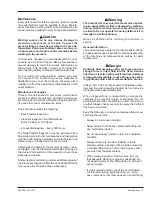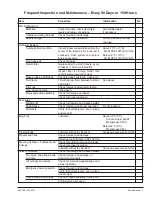
S2632E – 1420331
Maintenance – 1
7. Never let the electrolyte level of a lead-acid battery fall
below the plates. Lack of maintaining the electrolyte
in a lead-acid battery causes damage to the exposed
portion of the plate which reduces capacity.
8. Always check electrolyte level before charging. Do
not add water to individual cells unless plates are
exposed. Batteries should be watered after charg
-
ing unless the plates are exposed before charging.
If exposed before charging, the plates should be
covered by approximately 1/8
″
of water. Check water
level after charging. Water should be kept 1/4
″
below
the bottom of the fill tube in the cell cover.
9. Water used to replenish batteries should be distilled
or treated to not exceed 200 T.D.S. (total dissolved
solids... parts per million). Particular care should be
taken to avoid metallic solids (iron).
10. A fully charged battery will give you the best and
longest service. Be sure the batteries are fully
charged before testing or using. A fully charged bat
-
tery, without a drain or load, after the surface charge
has dissipated, is 6.35 volts for a 6 volt battery.
11. Batteries should not be discharged below 20% of
capacity (approximately 1.8 volts per cell under
normal operating load; 1.98 volts open circuit; 1.145
specific gravity). Proper battery sizing will help avoid
excessive discharge.
12. Battery chargers should be sized to fully charge
batteries in an eight hour period. Chargers should
be kept in proper operating condition.
13. Do not use a mismatched charger of any type; i.e.,
a 12 volt charger on a 24 volt pack or a 24 volt
charger on a 12 volt pack. An undersized charger
will never get the job done, no matter how long it
tries. An oversized charger will cause excess gas
-
sing and heat that could possibly result in a battery
meltdown and/or explosion.
14. Never charge a lead-acid battery with a sealed (gel
cell) battery charger. The lead-acid battery needs
higher voltage to finish its charge. Without it the
battery will never come back to 100% and sulfation
can occur.
15. Always allow batteries to cool off after charging.
The cooling time is very important because heat
is generated during the recharge and discharge
cycles. Without the cooling time the heat grows,
accelerating grid corrosion which is one of the major
causes of battery failure. Charging practice should
enable batteries to cool before use.
16. Deep cycle batteries need to be equalized peri
-
odically. Equalizing is an extended, low current
charge performed after the normal charge cycle. It
helps keep cells in balance. Actively used batteries
should be equalized once per week. Manually timed
chargers should have the charge time extended
approximately 3 hours. Automatically controlled
chargers should be unplugged and reconnected
after completing a charge cycle.
17. In situations where multiple batteries are connected
in series, parallel or series-parallel, a replacement
battery's should be of the same size, age and usage
level as the companion batteries. Do not put a new
battery in a pack that has 50 or more cycles. Either
replace all the batteries with new batteries or install
a good used battery's in place of the bad. New bat
-
teries should be given a full charge before use.
18. Periodic battery testing is an important preventa
-
tive maintenance procedure. Hydrometer readings
of each cell (fully charged) give an indication of
balance and true charge level. Imbalance could
mean the need for equalizing and is often a sign
of improper charging or a bad cell. Voltage checks
(open circuit, charged and discharged) can locate
a bad cell or weak battery. Load testing will pick
out a bad cell when other methods fail. The point
is to look for the abnormal. A weak cell or battery
will cause premature failure of companion cells or
batteries respectively.
19. As batteries age, their maintenance requirements
change, Generally their specific gravity is higher and
gassing voltage goes up. This means longer charging
time and/or higher finish rate (higher amperage at the
end of charge). Usually, older batteries need to be
watered more often and their capacity decreases.
20. “Opportunity charging”, a short partial charge during
an extended duty cycle, is a controversial subject.
Generally, the practice is a “crutch” to make up for
undersized batteries. The correct approach is to
install adequate battery capacity. If this is impossible
because of lack of space in the battery compartment
or extreme operating conditions (24 hour intermit
-
tent use, as an example), “opportunity charging” is
better than excessive battery discharging. However,
the practice can cause batteries to overheat, require
more watering and usually will shorten battery life.
“Opportunity charging” is a trade off; something to
avoid if possible. One charging cycle per day is
preferable.
21. Extreme temperatures can substantially affect bat
-
tery performance and charging. Cold reduces bat
-
tery capacity and retards charging. Heat increases
water usage and can result in overcharging. Very
high temperature can cause “thermal run away”
which may lead to an explosion or fire. If extreme
temperature is an unavoidable part of an application,
consult a battery/charger specialist about ways to
deal with the problem.
22. An overly discharged battery might need to be cycled
a few times before it can recover fully. If a battery
begins to heat before coming up to a full charge,
Summary of Contents for S2632E
Page 8: ...S2632E 1420331...
Page 9: ...S2632E 1420331 Repair Parts Repair Parts...
Page 10: ...Repair Parts S2632E 1420331...
Page 11: ...S2632E 1420331 Repair Parts Chassis Steering and Brakes Chassis Steering and Brakes 1420247 1...
Page 12: ...Repair Parts S2632E 1420331 Pothole Protector Pothole Protector 1420247 2...
Page 14: ...Repair Parts S2632E 1420331...
Page 16: ...Repair Parts S2632E 1420331...
Page 18: ...Repair Parts 10 S2632E 1420331...
Page 22: ...Repair Parts 14 S2632E 1420331...
Page 24: ...Repair Parts 16 S2632E 1420331...
Page 26: ...Repair Parts 18 S2632E 1420331...
Page 28: ...Repair Parts 20 S2632E 1420331...
Page 30: ...Repair Parts 22 S2632E 1420331...
Page 32: ...Repair Parts 24 S2632E 1420331...
Page 35: ...S2632E 1420331 Hydraulics Hydraulics...
Page 36: ...Hydraulics S2632E 1420331...
Page 38: ...Hydraulics S2632E 1420331...
Page 40: ...Hydraulics S2632E 1420331...
Page 42: ...Hydraulics S2632E 1420331...
Page 44: ...Hydraulics 10 S2632E 1420331...
Page 46: ...Hydraulics 12 S2632E 1420331...
Page 47: ...S2632E 1420331 Electrical Electrical...
Page 48: ...Electrical S2632E 1420331...
Page 50: ...Electrical S2632E 1420331...
Page 54: ...Electrical S2632E 1420331...
Page 58: ...Electrical 12 S2632E 1420331...
Page 62: ...Electrical 16 S2632E 1420331...
Page 66: ...Electrical 20 S2632E 1420331...
Page 70: ...Electrical 24 S2632E 1420331...
Page 74: ...Electrical 28 S2632E 1420331...
Page 78: ...Electrical 32 S2632E 1420331...
Page 82: ...Electrical 36 S2632E 1420331...
Page 86: ...Electrical 40 S2632E 1420331...
Page 88: ...40 2 S2632E 1420331...
Page 90: ...Electrical 42 S2632E 1420331...
Page 92: ...Electrical 44 S2632E 1420331...
Page 94: ...Electrical 46 S2632E 1420331...
Page 96: ...Electrical 48 S2632E 1420331...
Page 98: ...Electrical 50 S2632E 1420331...
Page 108: ...Electrical 60 S2632E 1420331...
Page 109: ...S2632E 1420331 Options Options...
Page 110: ...Options S2632E 1420331...
Page 112: ...Options S2632E 1420331...
Page 114: ...Options S2632E 1420331...
Page 116: ...Options S2632E 1420331...
Page 118: ...Options 10 S2632E 1420331...
Page 120: ...Options 12 S2632E 1420331...
Page 122: ...Options 14 S2632E 1420331...
Page 123: ...S2632E 1420331 Maintenance Maintenance...
Page 124: ...Maintenance S2632E 1420331...
Page 128: ...Maintenance S2632E 1420331...
Page 134: ...Maintenance 12 S2632E 1420331...
Page 135: ...S2632E 1420331 Maintenance 13 Major Repairs Date Part Number Part Description Repair Performed...
Page 136: ...Maintenance 14 S2632E 1420331...
Page 142: ...Maintenance 20 S2632E 1420331...
Page 146: ...Electrical Schematic 4...
Page 147: ...Hydraulic Schematic 1 Hydraulic Schematic S2632E All Machines A37023B...
Page 148: ...Hydraulic Schematic 2...
Page 153: ......
































